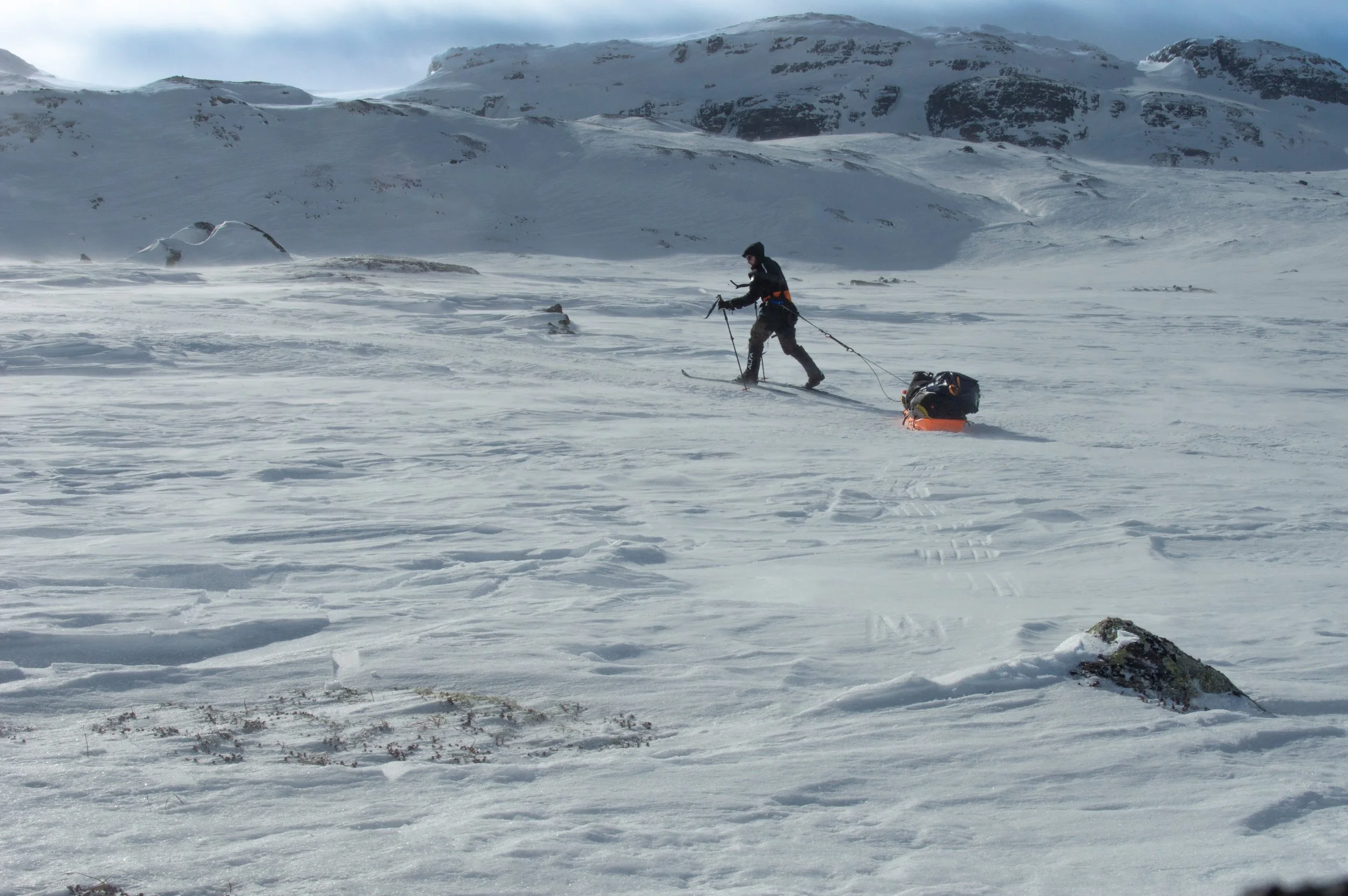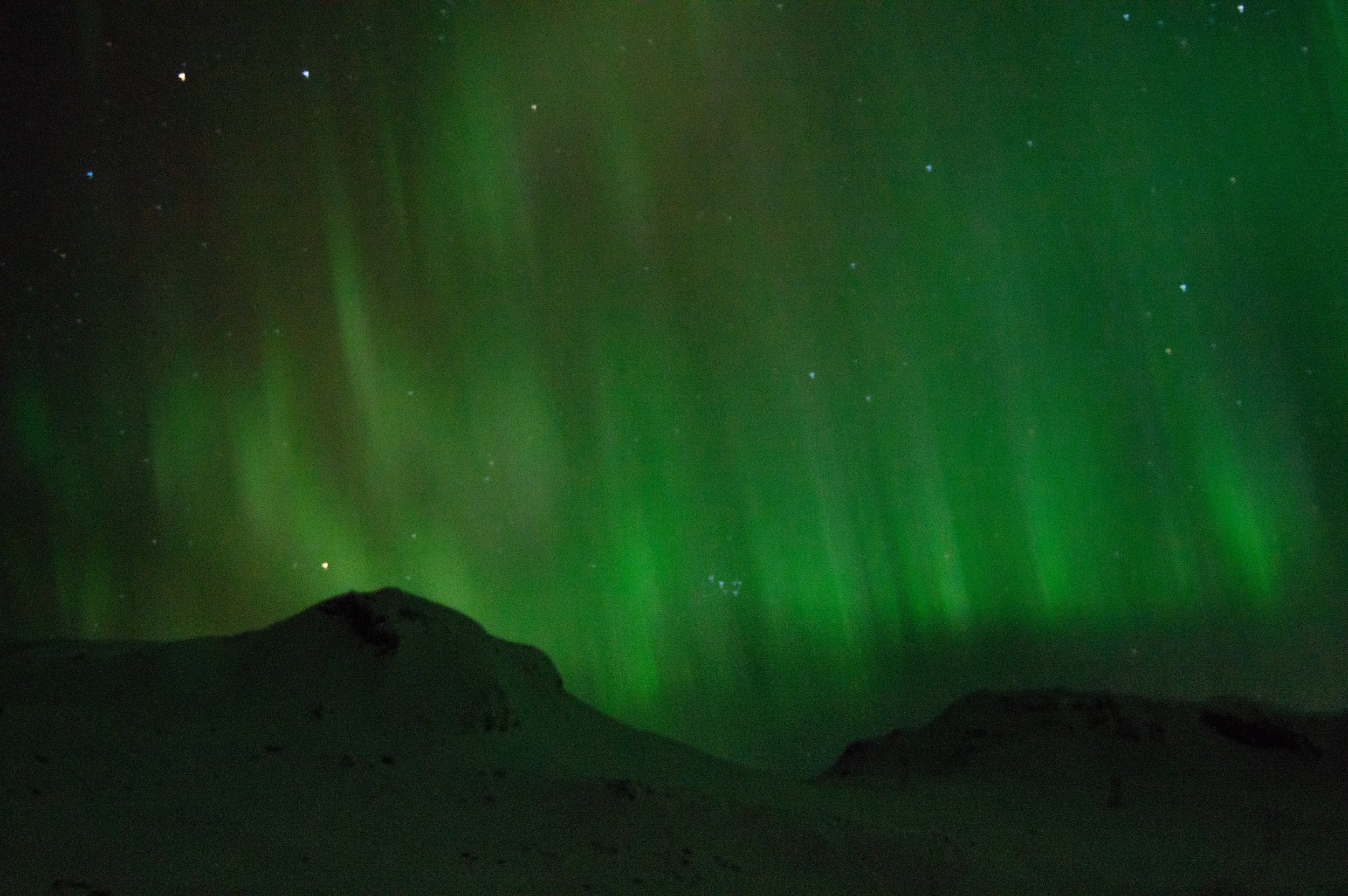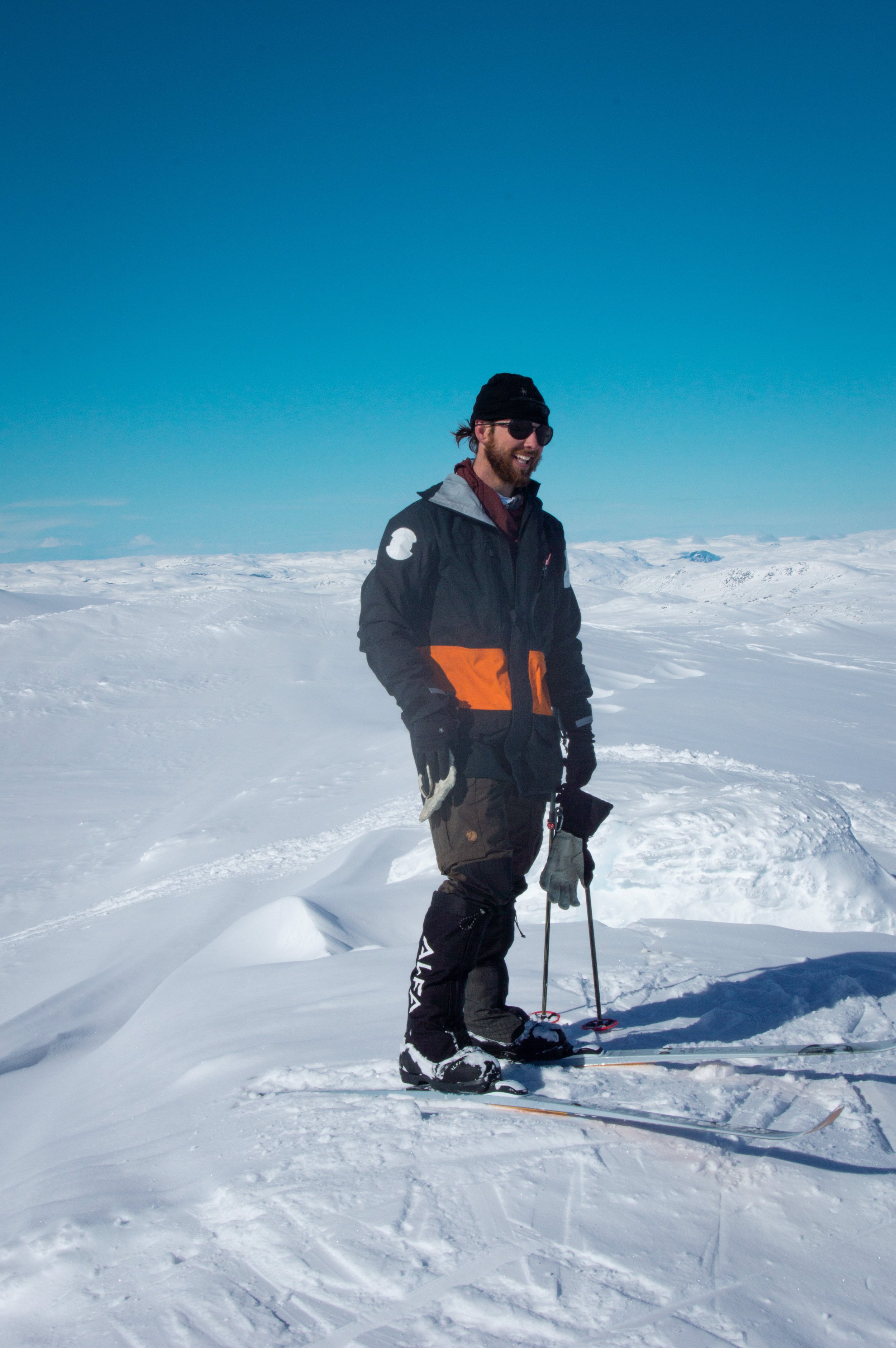TRAQ23: Alone on a Glacier
This Expedition, The Tested Resilience Arctic Qualifier (TRAQ23), is the final qualifying component of my training in an effort to become the youngest person in human history to ski the 700+ miles solo to the South Pole. Pending final approval, I intend for that expedition to begin November 2023. If you would like to support this world record-setting expedition, please contact me at Myers.JacobG@gmail.com or through the contact form on my website www.ValhallaHikes.com
After over two years of training, acquiring gear, and practicing the routines that would keep me safe in the polar regions I was finally standing at the foot of the Hardangerjokulen. This glacier, apathetic to my presence and unwavering in its desire to produce brutal fronts of wind and whiteout, is a culmination of so much that I’ve been working toward. My skis were running along the same landscape as the legends of the heroic age of polar exploration. The monument to the Scotts, Amundsens, and, my personal favorite, Oates, of that era stands alongside the nearby village of Finse signifying just how historic this landscape is.
My route was a little convoluted, but approachable enough. Within the next three weeks I would ski through every condition in complete isolation. During that time my goal was to circumvent the glacier, drag my pulk up and over the mountains that separated the marked trail from the Southern ramp of the glacier, climb up and over that ramp, and then explore the mountains North and West of the village before returning a qualified candidate for my solo to South Pole expedition. I knew where I wanted to go, but the goal had far more to do with proving I could hack it on my own than traversing any particularly arduous routes.
Week One
I made my way across Finsevatnet, the frozen lake blanketed in a sheet of ice over 10 feet thick, as another party I was acquainted with was also heading out into the field. I took the long way around the lake as to allow some separation between myself and them, and as I climbed over the flanks of the glacier and the sun began to descend upon the horizon, I pitched my tent between two boulders and dug in for my first night in the field. The first couple nights always come with an adjustment period for me beit a thru-hike or polar travel. Sleeping on the ground has never been something I find uncomfortable, but with this entire journey in front of me, the vast majority of which will go on without me seeing another living creature, I spent most of the night tossing and turning in the snow.
Now the first morning, that, right there, is something special. A small layer of ice frosted the inside of my tent, communicating to me that I needed to open the ventilation a bit wider on my tent the next night (did y’all know you breathe out over half a pint of water in the night? Managing this in the Arctic is important, as it’s similar to pouring that half a pint of water across all your gear every morning, slowly degrading the quality of most down-insulated products and potentially filling electronics with ice if one is negligent). I melted snow for the day’s drinking water, rehydrated some oatmeal, and packed up all the equipment into my pulk.
I remember struggling not necessarily with the weight of my pulk, though it was in the range of 150 pounds at the start, but with how awkward the poor thing was. In order to provide smooth travel, the heaviest pieces of equipment should be at the back of the pulk, and everything should be neatly tucked into the hull. My rig had mostly that, but I also had to strap on 3 weeks worth of food in a waterproof duffle atop the pulk, making it flip over when traversing side slopes. This made the damn thing the absolute bane of my existence for the first whole week of the expedition. Everytime I would fall into a rhythm, moving confidently through the wind and low visibility of that first leg, it would tip over, undoing the equilibrium of the food bag atop the pulk, and forcing me to rerig it else it would get even further off balance. But the game goes on.
Whiteout conditions were a staple of that first third of the journey. I remember the fourth night of the trip where over a foot of snow had dropped down in the night. It came in such abundance that I I would set an alarm on my watch to wake me every four hours so that I could get back into my weatherproof gear, walk out into the blizzard, and dig my tent free by headlamp so that it did not get buried and collapse on me in the night. This process was repeated only one other night during my expedition with two nightly diggings each time. Some bizarre, masochistic part of me was really excited to be experience this though, as a similar experience, though one with flying shards of glass-like ice that went on for four days, had happened to a friend of mine and only now could I really begin to approach understanding how hilariously frustrating that situation is.
I approached the South ramp for the first time in the middle of the week. The ramp itself looks incredible, and the grade not too sharp even with the pulk behind me. Getting up onto the ramp, however, was the struggle. A handful of small but steep hillsides stood against the glacier like a rampart. In order to get over these walls I opted to ski alongside the flanks of the lakes so that I already had some of the elevation gain under my belt. Pulk flipping aside, this worked wonderfully, and I had gotten well over half the necessary climbing in on very navigable terrain.
As I approached the last few climbs, I was faced with a technical skirt around a boulder that bulged out of the snow in my path. My plan was to take my skis off, kick in some foot buckets, and walk my pulk around the rock where I could then reequip my and access the ramp. It was a good plan, and I would argue the execution was fine too, but one thing I couldn’t account for was a patch of snow beneath the rock so hard I couldn’t get any buckets in. You dig buckets with your heel in ski boots so that you don’t damage the toe bar that connects you to your skis, and so there I was on this frozen ledge, slowly inching my way around the boulder. The going was intimidating but manageable, and it wasn’t until the hard snow turned into a hollow that I ran into trouble. With one massive stomp that a mere foot before could barely break the crust now drove me up to my knee. I sank, the pulk hit me in the head, flipped over me, and ripped me out of this snow hole as it sent me rocketing down the mountainside. I retched against my leash and fought to get my feet pointing downhill again, but I was moving too fast to stop and with the sled kicking up so much snow I couldn’t see a thing. My head flashed with pictures of me getting slingshotted into a rock and breaking my legs, or worse the sled dragging straight off one of the nearby cliffs where I wouldn’t even be able to comprehend I was freefalling until it was already too late. Not being able to see meant I couldn’t even attempt to direct the speeding behemoth toward the safest path, and so I simply slid on my ass and braced for whatever was to come next. Nothing came, of course, and I’m fully cognizant of how lucky that makes me. The pulk shot down the mountainside and into an open field of snow where it and I eventually came to a halt. I caught my breath, composed myself, and spent the rest of the afternoon carefully evaluating my gear. Neither I nor any single piece of equipment were damaged in any way, ego aside.
Week Two
After that first week of deep snow and a failed summit of the glacier on the South ramp I decided to swing back up and around the glacier to head into the Northern range. I was still off the beaten path by this point, and this meant the two days of intense whiteout allowed me to practice a skill I’ve been wanting to dial for some time. Using my GPS location I transposed myself against the paper Topo map of the region, took a compass bearing that would direct me to the nearby ridge, and planned a series of ‘void hops’ as I called them (Read: Kabloona where the author speaks of traversing whiteout like delving into another dimension or “void.” This was also my experience) where I’d ski until I hit the side of a mountain, pick a new bearing, follow that compass bearing until I hit another mountainside, and continue the process until I navigated my way out of the wilderness. I’m thrilled to say that this went with perfect success in me dodging the snow traps and cliffs that lay outside my bearing and provided me with one of the single most powerful psychedelic experiments I’ve ever had. I couldn’t ever tell whether I was moving uphill or downhill, and with no landmarks of any kind around me, it was almost as if I skied standing still inside a shaken snowglobe. Once every hour or so I’d see a rock, and in less than a single minute it would fall completely out of existence, consumed by the void. I was not navigating through the Earth, rather I was a hamster spinning a wheel until the Earth came to me.
I made it back to the marked trail in good fashion, and with navigation taken out of my hands I daydreamed as I skied along. The void eventually fell away to a rather beautiful snowscape, and other than how slow I was going thanks to the soft snow, I really enjoyed myself. I made it back to Finse and slept in our company warehouse for the night so that I could fix a nagging issue with my solar panel. Returning to civilization for any reason disqualifies any claims I may have had to a fully unsupported expedition on the glacier, but my priority will always lie with my, and when applicable, my team’s safety, so I took the opportunity to fix the issue and maintained GPS and coms with my team for the remainder of the trip.
A quick checkin with my mentors, a fixed panel, and reindeer for dinner (why not indulge) left me feeling fantastic before jumping back into the field for the remainder of the journey. I skied onto the North ramp of the glacier in the hopes that gaining elevation would allow me to avoid the incoming rain (yes, you read that right, Winter rain on the glacier). It did not. C’est la vie.
A few wet days in the field were nothing but a mild annoyance and another opportunity to practice my skillset. Many folks have asked me what’s the secret to not getting cold out there, and I still maintain that there isn’t one. It’s about learning to cope. Can’t see? Learn to navigate by map and compass. Temps sinking to dangerously cold levels? Learn how to keep your skin covered while still ventilating your breathing (that whole breathing out moisture thing again). Raining in the Arctic? Practice brushing ice off zippers, keeping baselayers dry, and maintaining tech. It is ALL about developing a skillset that allows you to cope with conditions, not stressing about what the conditions actually are.
Week Three
The last week of the trip I found myself playing in the North range, though only for a moment. The maps don’t tell you that the North range is where Finse receives its water supply, and, as such, camping is prohibited there both Winter and Summer to avoid any contamination. I split my two days in the range into one very big day, and after dragging my pulk, a bit lighter with two weeks’ less food in it but still rather heavy on steep inclines, through the mountains all day I decided to take the following day off and hang out in my tent just outside the village. It’s only now that I’ve been informed how the employees could hear singing alone in my tent during their smoke breaks, and I hope that made them smile a bit. Singing is what keeps me sane in the mountains, and my music was more than enough to feel as if I had some sort of human interaction while living in a state of self-imposed quasi exile in the frozen wilderness.
From the North range I skied West to Hallingskeid. The hut system here in Norway is really great, and were this a different kind of trip I’d really have liked to connect with folks and hear their stories while we hut hopped. I slept alone in the valley instead and was awoken in the night by the third rescue helicopter I’d seen during my time. It’s a pretty sobering reminder not to get too comfortable or complacent in a place like this. All it takes is a moment of lapsed focus for the wind to sweep your gloves away and off into infinity. Tripping over a guyline and falling onto your tent can snap a pole and potentially leave you without shelter in a very hostile environment. Neither of these were the fate of the victims the helicopter was charging towards. I found out much later that they had fallen in a crevasse on the South ramp of the glacier… the same crevasse that thwarted my second attempt at summitting the Hardangerjokulen from the South. The news filled me with a mix of anxiety for those two poor souls and bolstered the confidence I had in my decision to turn back out of fear that I would have fallen in the very same trench of ice.
After enjoying some mild days West of the glacier, I returned by the village for a third attempt at a summit. This time it would be via the well-marked and safe North ramp. The summit tasted just as sweet as I imagine it would’ve from any other approach as I was greeted with a clear, sunny day for my push to the top. Clear sunny days are a rarity for a glacier that seems to perpetually manifest such intense weather. I bumped into a Norwegian fella at the summit and asked him to photograph me. With so few Americans in this part of the world he greeted me by asking if I intended to camp out our stay in the hut. “I’ll camp again. Actually, I’ve been camping out here for 20 days now” was my response, and he laughed from his belly in turn. I appreciated the way he said “crazy Americans” as he waved and eventually disappeared off the glacier’s horizon.
The summit came just shy of my one-year anniversary of the first time I’d stood atop it. Hundreds of hours of training, major endurance projects, exped planning, and fundraising has gone on since then, and I’m blessed to feel so close to realizing my dream in Antarctica. I came off the glacier, camera heavy with a month’s worth of photos and my belly elated at the thought of reindeer and a hot cup of coffee (I took a much needed break and had no caffeine the entire journey), and settled into a night with very little sleep.
The next morning, as with any other day, I brushed the inside of my tent, attended to my morning routine, and packed my pulk. I then made my way back to Finse to meet my team and add this extended solo trip to my polar resume, elated at all the variety it provided and the way in which it reinforced all the work I’d been putting in these last couple years.
It’s behind me now, and in front of me stands my first month of working as an assistant guide on the very same glacier. Further out still, though feeling really close these days, is November, and November means I finally get to prove that I have what it takes to get to the South Pole and punch my name onto the short list of people who’ve skied that holy track of snow.
Thank You
To the amazing folks that’ve supported me in getting to this point, thank you for believing in my dream, and I hope you feel more confident now than ever that this thing will go.
To my mentors who’ve shown me the ropes and the rest of the polar community that has been so welcoming to me, trust that I take every duly-tested piece of advice to heart, and I place faith in your collective expertise to guide me to the Pole this Winter.
To Appalachia and every kid who grew up in the holler like me, know that this endeavor says not that I am an outlier born to test myself in the harsher corners of the world but instead proof of the resiliency that exists within our community. I hope to bring this world record back home for all of us.








